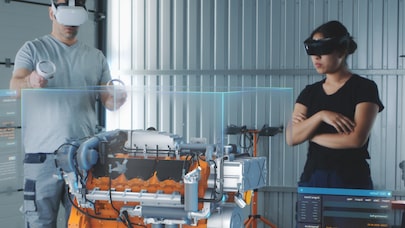Metaverse

How can you improve productivity across human, physical, and digital worlds?
With optimally engineered networks that seamlessly bring new, immersive experiences together.
The metaverse's immersive experiences will heavily depend on the seamless flow of data across networks, serving as the lifeblood that connects users, environments and virtual interactions. In a world that endlessly evolves, another paradigm shift is on the horizon. One that promises to reshape the very fabric of our digital lives—the metaverse.
In a world that endlessly evolves, another paradigm shift is on the horizon One that promises to reshape the very fabric of our digital lives: the metaverse. Metaverse innovations will steadily progress and take time to be fully realized. XR devices, digital twins and sensors are already delivering tangible value to enterprise and industrial environments. But, connecting the human, physical and digital worlds without a more cognitive, automated and ultra-responsive network infrastructure, the metaverse will remain a figment of imagination. Every immersive experience, every lifelike interaction, and every real-time collaboration hinge on the seamless flow of data, connecting users from every corner of the globe. The quality of networks will be critical to ensuring that users have a seamless and immersive experience in the metaverse.
Citi GPS predicts a metaverse economy to be worth $8 trillion to $13 trillion by the year 2030.
Nokia’s Global Network Traffic report projects metaverse traffic alone to be as much as 495.2 exabytes per month in 2030.
By 2025, manufacturing industry digital twins are forecast to reach a market size worth over $6 billion.
Service providers
Get the insights
Service providers form the backbone of our interconnected digital world and are poised to play a pivotal role in shaping, supporting, and generating value for consumers, enterprises and industrial customers. Without the network, there is no metaverse. We anticipate:
Metaverse breakthroughs, like extended reality (XR) and digital twins, combined with AI, cloud and Web3 technologies will create greater network demand and will bring new opportunities for service providers beyond connectivity for consumer, enterprise and industrial customers. Network demands will expand due to rising metaverse traffic that requires high uplink and downlink speeds, ultra-low latency and aptly engineered edge networks to provide an immersive, smooth user experience.
Enterprise and industrial customers are already using XR devices to provide tangible value for collaboration, training, and on-the-job assistance. Continuous R&D will address fundamental technological challenges to make XR devices more appealing, comfortable, and affordable in the consumer space. When XR devices are ready for widespread adoption and usage, they will be deployed quickly and will open consumer, enterprise and industrial customer opportunities. Within the next decade, augmented reality (AR) will surpass virtual reality (VR) as the most widely used XR technology in consumer applications, customer interactions, enterprise productivity, and industrial operations.
Network demands will expand due to rising metaverse traffic that requires high-speed, low-latency networks to provide an immersive, smooth user experience.
5G-Advanced adoption and the monetization of network investments will accelerate with the increasing use of XR devices, digital twins, metaverse platforms and consumer, enterprise, and industrial applications.
Together with AI analytics and virtual assistants, metaverse technologies have the potential to revolutionize customer service, sophisticated self-installs, and troubleshooting to improve the quality of their customer’s experiences.
As metaverse technologies bring greater demand on the network it will need to evolve. Digital twins will enhance network planning, performance monitoring, and alternative what-if-scenario simulations for network optimization.
Priorities
- Develop a metaverse strategy for consumers, government, businesses, and industries. Consider roles as connectivity infrastructure foundation provider, cloud infrastructure provider, metaverse platform provider, and metaverse experience co-creator in the metaverse value chain.
- Plan your metaverse infrastructure. Estimate metaverse traffic and compute demands for proto-metaverse applications like smartphone AR, multi-user virtual world platforms, and cloud gaming and future XR applications like volumetric video, XR cloud gaming, and synthetic agents. Consider your network augmentation and expansion timeline.
- Make your future network metaverse-ready with 5G-advanced, 6G, XGS-PON, flexible edge clouds, and a cognitive and cloud-native transport fabric to meet cloud-hosted content and compute throughput and latency demands. Ensure that your future network architecture supports ubiquitous AI for automation and intelligent operations.
- Experiment with and deploy network APIs (such as Quality on Demand and location) to innovate and monetize proto-metaverse applications like consumer cloud gaming and enterprise spatial collaboration, laying the groundwork for future metaverse XR services.
Enterprises
What’s next?
We are adapting to an ever-changing technology environment and continuously innovating our products, services and practices to meet metaverse demands.
Our ever-evolving solutions and portfolio are well engineered keeping in mind the stringent needs of the Metaverse application and services across consumer, enterprise, and OT. Moreover, our network architecture for 2030 caters to these evolving performance and service delivery requirements for a seamless application integration and end-user experience. We are excited to collaborate with you in determining your metaverse requirements and assisting you in evolving your networks with cutting-edge solutions to be future-ready.






